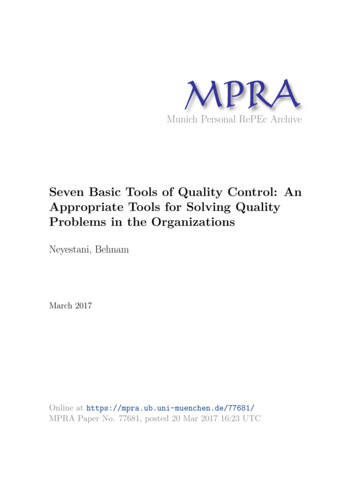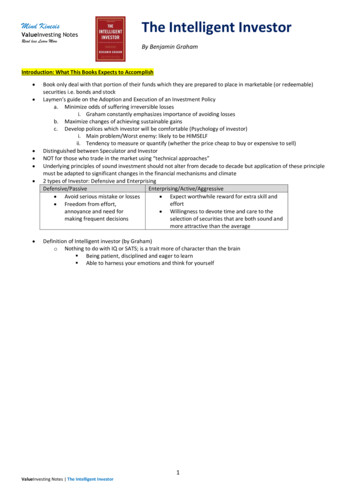
Transcription
How to LeadLead Your People to Success
How to Lead: Discover the Leader Within YouBy James Manktelow, Felix Brodbeck and Namita AnandThis workbook is published by:Mind Tools Ltd3rd FloorThe News BuildingLondon Bridge StreetLondonSE1 9SGUnited KingdomCopyright Mind Tools Ltd, 2016.ISBN 0-9545586-3-4.Version 2.0.Copyright Notice:Copyright 2016, Mind Tools Ltd. All rights reserved.This e-book is protected by international copyright law. You may only use it if youhave downloaded it directly from MindTools.com, or if you have been providedwith it under a corporate license.If you have received this from any other source please contactcopyright@mindtools.com.“Mind Tools” is a registered trademark (US 4,566,696, EU 012473377) ofMind Tools Ltd.To purchase a license, just place your order at www.mindtools.com/rs/HowtoLead.Cover image GettyImages/enviromantic.
ContentsModule 1: The Meaning of Leadership11.1.A Portrait of a Leader1.2.Leaders: Born or Made?1.3.What Makes a Leader?1.3.1. The Leadership Process1.3.2. Approaches to Leadership1.3.3. Today's Leader1.4.This Course: A Way to Develop an Effective, Authentic Leadership Style1.5.The Structure of the Workbook1.6.Module Structure1.7.Exercise146791112131516Module 2: Get to Know Yourself172.1.Introduction2.2.Introduction to Tools2.2.1. Leadership Motivation Assessment2.2.2. Self-Confidence Assessment2.2.3. Disposition Assessment2.2.4. Emotional Intelligence Assessment2.2.5. Transformational Leader Assessment2.3.Apply This to Your Life1821222426303338Module 3: Get "The Right Stuff"3.1.Introduction3.2.Introducing the Tools3.2.1. Motivation Builders3.2.2. Confidence Boosters3.2.3. Positive Attitude Enhancers3.2.4. Communication Effectors3.2.5. Emotional Intelligence Sensitizers3.3.Apply This to Your LifeHow to Lead: Discover the Leader Within You Mind Tools404143435054576067iii
Module 4: Create Winning Ideas4.1.Introduction4.2.Introduction to Tools4.2.1. Information Gathering – Information Is Inspiration4.2.2. Change Monitoring – Staying Ahead of Events4.2.3. “Stealing” Inspiration – 1 1 44.2.4. Scenario Thinking – Understanding Different Futures4.2.5. Generating and Testing Your Vision4.2.6. Crafting a Compelling Story4.2.7. Bring Out Values People Can Believe in4.3.Apply This to Your Life6869717274757679808282Module 5: Get the Power to Rouse845.1.Introduction5.2.Introduction to Tools5.2.1. Direction Setting – Using Vision to Fire Inspiration5.2.2. Ownership Invitation – Harness the Power of Partnership5.2.3. Frame Alignment – Answer the WII-FM Question5.2.4. Expert Power Sources – Lead From the Front5.2.5. Referent Power Sources – Energize, Enthuse, Infuse5.2.6. Communication – Make Inspirational Appeals5.3.Apply This to Your Life859292969799101102103Module 6: Getting Things Done1046.1.Introduction6.2.Introduction to Tools6.2.1. Task Allocation – Pick the Right Player for the Right Job6.2.2. Goal-Setting – Define the Target; Provide an Objective6.2.3. Standard Definition – Spell Out the Rules for an Honest Game6.2.4. Establishing Communication – Communicate, Connect, Accomplish6.2.5. Personal Involvement – Give Support to Win Support6.2.6. Follow Through – Make the "End" Count6.2.7. Team Building – Making the Whole Greater Than the Sum of the Parts6.3.Apply This to Your Life105105106108109111115115117120Module 7: Develop Your People1217.1.Introduction7.2.Introducing the Tools7.2.1. Understanding People’s Developmental Needs7.2.2. The Coaching Approach Quadrant – Different Strokes for Different Folks7.2.3. Delegation Strategies – Strike the Right Balance7.3.Apply This to Your Life122124124127130132How to Lead: Discover the Leader Within You Mind Toolsiv
Module 8: Get the Extra Edge1338.1.Introduction8.2.Introduction to Tools8.2.1. Risk Taking – Calculate Your Chances8.2.2. Networking – Work the Web8.2.3. Cross-Cultural Management – Reap the Benefits of Diversity8.2.4. Change Management – Make Transitions Smooth8.2.5. Letting Go, a Little 8.3.Apply This to Your Life134134134137139141142142Moving On 143How to Lead – Reminders 144References145How to Lead: Discover the Leader Within You Mind Toolsv
Module 1:The Meaning of LeadershipLife is not easy for any of us. But, what of that? We must have perseveranceand, above all, confidence in ourselves. We must believe that we are gifted forsomething, and that this thing, at whatever cost, must be attained.– Marie Curie, discoverer of Radium and double Nobel Prize winner1.1. A Portrait of a LeaderAt the age of seven, a young boy and his family were forced out of their home.The boy had to work to support his family. At the age of nine, his motherpassed away. When he grew up, the young man was keen to go to law school,but had no education.At 22, he lost his job as a store clerk. At 23, he ran for state legislature and lost.The same year, he went into business. It failed, leaving him with debt that tookhim 17 years to repay. At 27, he had a nervous breakdown.Two years later, he tried for the post of speaker in his state legislature. He lost.At 31, he was defeated in his attempt to become an elector. By 35, he had beendefeated twice while running for Congress. Finally, he did manage to secure abrief term in Congress, but at 39 he lost his re-election bid.At 41, his four-year-old son died. At 42, he was rejected as a prospective landofficer. At 45, he ran for the Senate and lost. Two years later, he lost the vicepresidential nomination. At 49, he ran for Senate and lost again.At 51, he was elected the President of the United States of America. The man inquestion: Abraham Lincoln.– Author UnknownMany of us are acquainted with this eloquent example of persistence in achievingvictory. We read it, stop for a moment and then sigh and say, “Wow! That’s the stuffreal leaders are made of.”And in saying this, it’s all too easy for us to think about leaders like Lincoln as“mythical creatures,” separate from the rest of humanity and empowered by somemysterious quality that smoothes their path towards inevitable success. This isthe view of leadership that many people have traditionally taken: that leadersHow to Lead: Discover the Leader Within You Mind Tools1
are marked out for leadership from early on in their lives, and that if you’re not aleader, there’s little that you can do to become one.However, that’s not the way we see it now. The modern view is that throughpatience, persistence and hard work, you can acquire the qualities of aneffective leader. And then, just as long as you make the effort needed, you canlead successfully.This workbook helps you find and develop these leadership qualities withinyourself. It shows you how to look inside yourself and understand your ownleadership strengths and weaknesses. It helps you build the passion, drive, will,and vision that others find so inspiring, and it then teaches you the essential skillsneeded to turn this vision into reality.And this module starts this process: First, we look at the foundation of the modern view of leadership, onwhich we’ll build in later modules.Next, we explain the framework we’ll use to help you realize yourleadership potential.And then, we map out the structure of the rest of this workbook. Thisshows you how the modules work together to build your leadership skills.Leaders Don t Wait for an Appointment LetterNow, I ask you to take another moment of reflection. When we said “That’s thestuff real leaders are made of,” just what is this “stuff” we attributed to former U.S.President Lincoln? What that made him prevail against all odds to emerge as agreat leader? It amounts to sheer determination and a desire to lead, doesn’t it?This leads us to the most basic truth of leadership:Leadership is a decision, not a position.Action:Look around your workplace and your community. Have you seen situationswhere the person in charge, the boss, did not actually lead? And haven’t youcome across instances where a person without any defined authority hascasually slipped into the leadership role?Using the worksheet on the next page, list these examples. Note down whyyou think the boss didn't function as an effective leader. And why was theperson without any formal authority able to take over the role?How to Lead: Discover the Leader Within You Mind Tools2
A Boss Who Does Not LeadA Leader Who isn’t the BossName, Position:Name, Position:Situation, Context:Situation, Context:Reasons:Reasons:How to Lead: Discover the Leader Within You Mind Tools3
You might have listed a variety of reasons for thesituation. Now consider: If the boss really wanted to lead, could he orshe not have been the leader?If the leader did not want to lead, could shehave actually assumed leadership?The answer is simple in most cases, which brings us tothe conclusion that:"The desire to lead is the most necessarypre-condition to becoming a leader."Once you decide you want to lead, you don’t have towait for anyone else to come along and appoint youleader. You just have to go out there and accept theleadership challenge.This is not to say that desire alone is enough toconvert you into a leader. You need to developand enhance specific skills, and you'll need a lot ofdiscipline and focus. It's not easy.However, if you want it badly enough and areprepared to work hard, you can become a highlyeffective leader.Yes, you might not be in charge, you might nothave any formal authority, you might be fetteredby a dozen limitations, but yet if you really want tolead, you can.Do you want to become a leader? If your answer is“yes,” then congratulations! You have already takenthe first step on the road to leadership. And ourcourse will provide you with the detailed road mapneeded to complete the rest of the journey. Use it,and soon – with hard work – you too will have met theleadership challenge.Mahatma Gandhi. No one "appointed" this man "leader."He didn’t hold any formal authority, yet he led anentire nation. iStockPhoto/robynmac.But if, deep down, you don’t want to lead, then it’s time for some soul searching.It’s time to understand what’s holding you back, and it’s time to challenge andovercome these issues. If you don’t, you’ll struggle to be an effective leader.1.2. Leaders: Born or Made?Like a musical instrument, genes do not determine what music is played.Genes simply define the range of what can possibly be played.– Warren Blank, Leadership AuthorHow to Lead: Discover the Leader Within You Mind Tools4
"Sure I want to become a leader, but I just don’t have it in me!” This self-doubt holdsmany of us back from embarking on the leadership journey.Ditch the doubt! Leadership is not the province of a select few; it is a learnableprocess. And if you truly want to, you can learn to become an effective leader.Asking “Are leaders born or made?” is like asking whether athletes are born or made.There is no single answer. We all know that both inherent talent and hard trainingare required to build an exceptional athlete (and even athletes with few naturaladvantages can achieve tremendous things with hard practice and commonsense). The real question is: “Can leadership be learned?”And the answer to this question is a clear, definitive “Yes.” As we’ve said, thegeneral perception is that leadership is a blend of special, mysterious qualities.Furthermore, we take it for granted that you are either born with this elusive“right stuff” or not. This is a myth; there is nothing mysterious about most of theingredients that go into the leadership cocktail. And rest assured that most ofthese essential elements already lie within your reach.You already possess some leadership skills and behaviors, you just need to learnto tap into them fully. Some of them may be unfamiliar to you now, but withperseverance and application, you can learn to cultivate them.Charisma and GeniusTraits such as charisma and genius fall mainly in the “born” category and can onlybe developed a certain amount. But we usually attach far more importance tothem than they actually deserve. No doubt such traits are a major advantage, yetthey are neither sufficient nor necessary to become a successful leader. In fact: If you have them and don’t complement them with other important skills,they may not amount to much.If you don’t have them, but compensate for this by strengthening otherskills, you can still become a successful leader.Management guru Peter Drucker uses Former U.S. President Harry Truman as acase study to underline this point: “Harry Truman did not have an ounce of charisma,yet he was among the most effective chief executives in U.S. history.”Becoming an effective leader, you see, is not about becoming a masterof all leadership skills. Rather, it is about recognizing your strengths andweaknesses and then finding ways to nurture the former and overcomethe latter.It's important to learn to recognize the tools and opportunities you have access to,and then use them effectively to carry you forward in your leadership journey. Thiscourse helps you in this identification and development process.How to Lead: Discover the Leader Within You Mind Tools5
1.3. What Makes a Leader?A strange thing happened in March 1999. The stock price of a large, profitablecomputer company fell unexpectedly. “So what!” you might say. Stock prices ofcomputer companies are known to fall a lot. But this was March 1999, long beforethe late 1990s Internet bubble burst. At that time, the stocks of all technologycompanies were on the up-and-up. Yet, the stock price of one of the most admiredcompanies, the Dell Computer Company , fell.This was considered quite strange because Dell was the exemplar of an innovative,high-performing technology company. It had invented the direct delivery modeland executed it admirably. Its sales and profits were the envy of the industry. Yet,its stock price suddenly dropped sharply. Why?An analyst with the Wall Street Journal offered an unusual explanation for thedrop in stock price, but given the circumstances, perhaps the only p
If the boss really wanted to lead, could he or she not have been the leader? If the leader did not want to lead, could she have actually assumed leadership? The answer is simple in most cases, which brings us to the conclusion that: "The desire to lead is the most necessary pre-condition to becoming a leader." Once you decide you want to lead, you don’t have to wait for anyone else .











